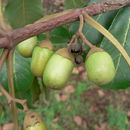en
names in breadcrumbs


Vitex doniana is a tree native to the Afrotropics. Its fruits are one of several fruits called black plums. This tree is often grown for its fruits.[1][2]
It grows to 4–8 metres (13–26 ft), and rarely up to 15 metres (49 ft). Its fruits are at most 2.5 centimetres (31⁄32 in) in length.[2] V. doniana is found at altitudes of 0–1,800 metres (0–5,906 ft)[2] in Ethiopia, Nigeria, Eswatini, Tanzania, Uganda and Zambia.[3] The insect Rastrococcus invadens is a pest to this plant.[3]
V. doniana is known as plem in Ethiopia, uchakoro in Nigeria, mfudu and mfuu in Eswatini, mfuu in Tanzania, munyamazi and yuelo in Uganda and kashilumbalu in Zambia.[3]
V. doniana is one of the few plants notable for its phytoecdysteroid content, Ochieng et al. 2013 finding it is one of the few with more than 0.001% by dry weight.[4] Specifically they find 21-hydroxyshidasterone, 11b-hydroxy-20-deoxyshidasterone and 2,3-acetonide-24-hydroxyecdysone.[5]
Vitex doniana is a tree native to the Afrotropics. Its fruits are one of several fruits called black plums. This tree is often grown for its fruits.